Peri Schwartz, whose work is currently on view in the three-person exhibition "Dwellings" at the Gerald Peters Gallery in Santa Fe, is a formalist and a seeker of harmonies. Schwartz's compositions get their rigor from the implied presence of a grid, which she offsets and punctuates with painterly gestures and harmonies of color and value. Her most recent oils -- studio interiors and still lifes of translucent bottles and jars -- have the expressive vitality of perfectly executed chamber music.
I recently interviewed Peri Schwartz and asked her about her background, her development, and her artistic values.
John Seed Interviews Peri Schwartz

Peri Schwartz: Photo by Donna Callighan
Peri, tell me something about your family background. Are you the first person in your family to take an interest in art?
Yes, the first in my immediate family but I have a lot of cousins that are artists.
My mother has a great eye and is one of my best critics. She also encouraged me from a very early age to pursue my passion. Her house is filled with beautifully framed drawings, paintings and prints from every stage in my development.
My cousin, Gary Schwartz, lives in Holland. He has written numerous important books on Rembrandt and other Dutch artists. One of the best memories I have was the first time I visited him and his family in the lovely town of Maarssen. He took me to the Rijksmuseum and pointed out Saenredam, an artist I had never heard of. Saenredam does magnificent paintings of church interiors and is an artist I frequently return to.

Maggie Painting, 1970, 23" x 19," oil on board
Tell me about your art education in Boston. What mentors made an impact on you?
Boston University's School of Fine Arts was a very serious place and I was in bliss. Our training in drawing and painting was traditional and very rigorous. Joseph Ablow taught composition and it was my favorite class. He had studied with Albers at Yale and was brilliant in demonstrating how a painting is constructed. He introduced me to Morandi, an artist that continues to inspire me.
Sometimes BU could be a bit too traditional. I was fortunate to be at a summer program BU had at Tanglewood. There I studied with Robert D'Arista, a terrific painter and teacher from American University. Unlike the teachers at BU, he wanted us to work quickly and intuitively. It shook me up quite a bit and I did some of my best student work that summer.
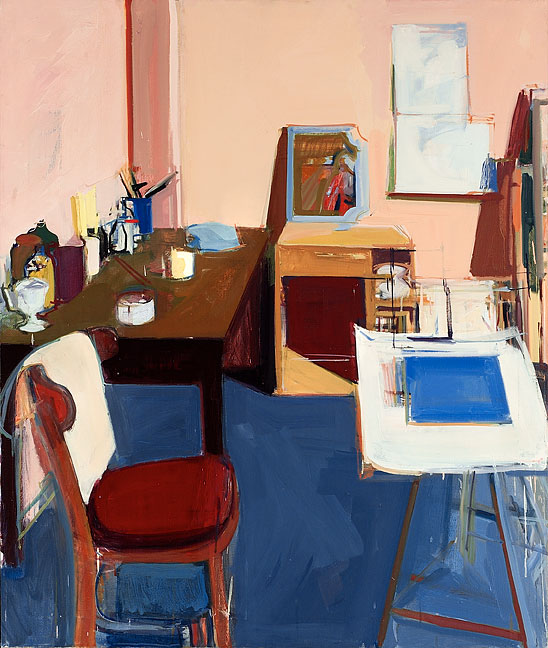
Studio, 1975, 52" x 44", oil on canvas
You think a bit like Vermeer: you like to turn your studio into an entire world. Tell me about that tendency and how it evolved.
I have two very vivid recollections of using the studio as a subject. The first was when I was at BU. It was dusk and I was alone in the drawing studio. I saw the easels silhouetted against the windows and did a charcoal drawing. The second time was when I had my own studio as a graduate student at Queens College. It seemed to be the perfect subject with a mirror, stool with pad on it and other painting materials. In that painting are all the things I continue to use in my studio interiors.
Yes, I look at Vermeer a lot and am especially interested in how he used the architecture of the windows as verticals and diagonals. Often the proportion of the painting or wall hanging is echoing the dimensions of the canvas. I find it fascinating that Vermeer was a strong influence on Mondrian, whose paintings are like skeletons of the Vermeers.
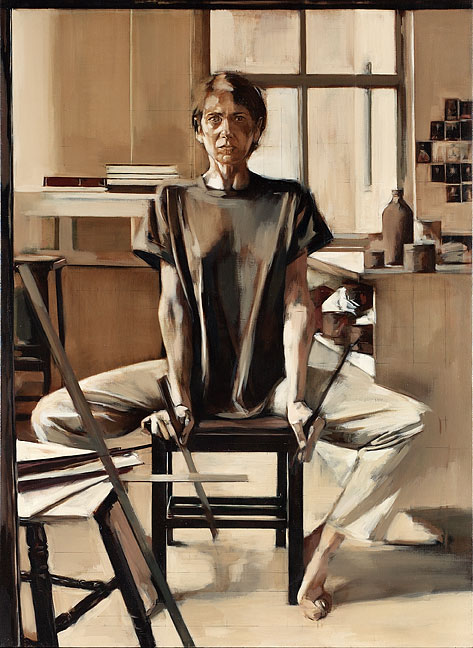
Studio Self-Portrait, 1998, 68" x 40", oil on canvas
You have said that the "grid is not a restriction." Can you expand on that?
I don't begin with a grid, the grid emerges. For example, in my Bottles and Jars paintings, I randomly set up the bottles and jars on the table. In trying to find the middle of the composition I measure where that will be. From there I divide it again and this is how the grid comes into play. It's a tool that helps me find the intervals. Often I will draw a line that is part of the grid, confident that it belongs where I drew it. As the painting progresses I inevitably move the bottles or jars and paint over part of the line. When the painting is done there are grid lines that weave in and out of the composition but are never uniform.

Studio XVIII, 2007, 56" x 44", oil on canvas
Many artists are afraid of rulers, but you aren't. Do you have a background in drafting?
No, but at BU we were taught how to use a plumb line when drawing the model. As my work developed I became more and more interested in how things lined up on that horizontal or vertical line. Instead of using a pencil I began using rulers. When I started drawing corresponding lines on the tables, floor and walls in my compositions, I needed more rulers that were longer.
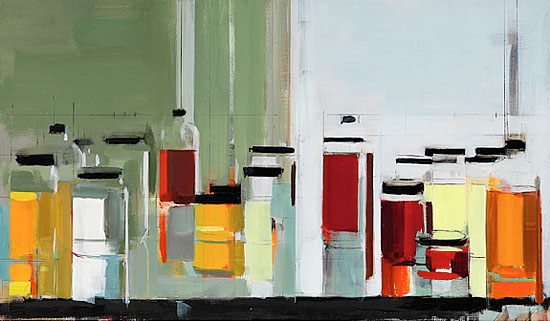
Bottles & Jars V, 2009, 20" x 32", oil on canvas
How do you know when a painting is finished?
For me, finishing a painting is a balancing act. I want to retain the freshness of the paint and at the same time get everything in the right position. The painting is usually finished when I can't bear to move one more object.
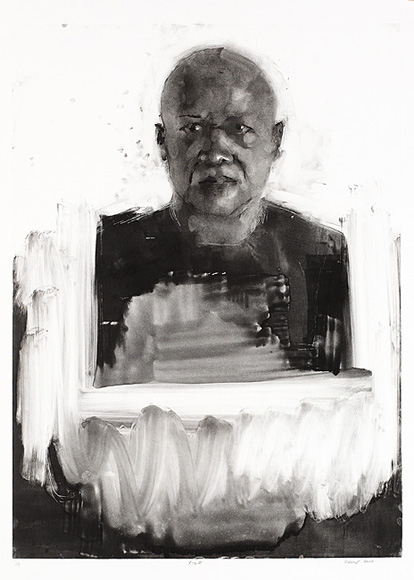
Roy II, 2012, 28" x 20", monotype
Although you are mainly known for still life imagery, you have done some wonderful monotype portraits. Do you plan on doing more work with the figure?
Thank you. I spent many years doing self-portraits. The portraits that I do are from people I know whose faces are interesting to me. I work directly from life and it takes me several hours to do a drawing or print. That makes it difficult to get someone to commit to posing. I am sure I will do more portraits but the timing has to be right for me and my subject.
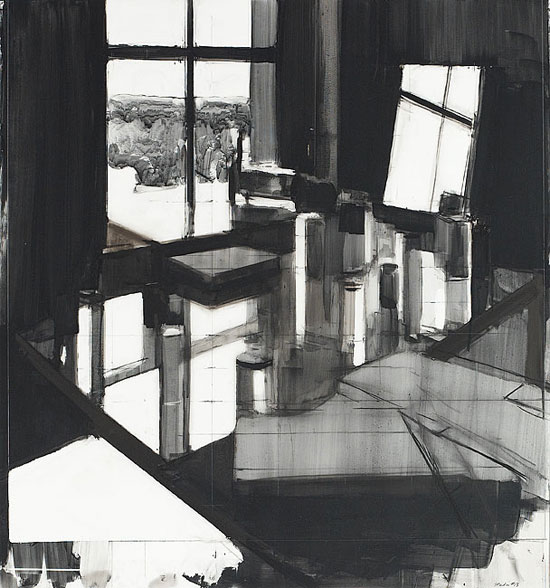
Studio #13, 2012, 30.5" x 28", charcoal and ink on mylar
In addition to your paintings, you create numerous black and white drawings: tell me about the importance of drawing to your artistic practice.
It has always been essential in my development to alternate between drawing and painting. There is a wonderful sense of rediscovering the materials after you have not used them for a while. I imagine drawing is like writing a poem or short story- the limitations lead to a certain kind of freedom.
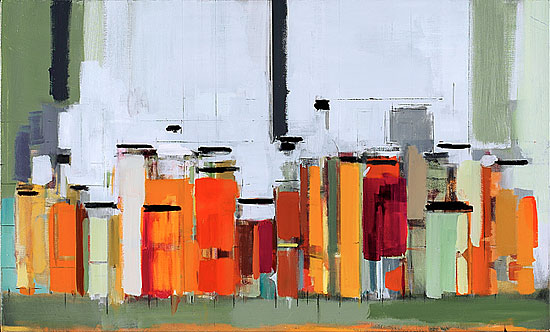
Bottles & Jars XXI,2011, 22" x 26", oil on canvas
What forces are pulling you towards abstraction in your work?
From the beginning of my art education, I have been interested in the compositions of great paintings, particularly Degas, Morandi and Diebenkorn. What interests me most is how they take a subject and use it to make a brilliant composition. I tend to seesaw back and forth with paintings that are more and then less abstract. Because working directly from life is so essential to me, I can't imagine doing a painting or drawing where the viewer is left without a sense of real space. Being on that edge is where I want to be.
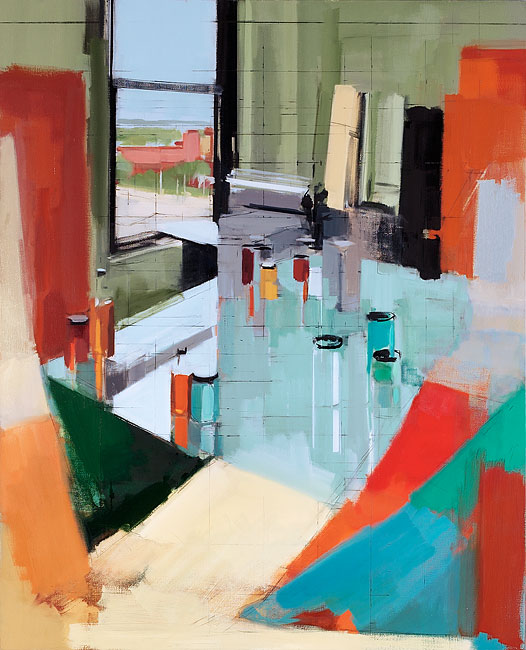
Studio XXXIV, 2013, 54" x 44", oil on canvas
What are your interests outside of art?
Listening to classical music, especially small ensembles, is vital to me. I go to concerts frequently and aside from getting emotionally involved in the music, I like to watch how the musicians communicate with each other. When I am back at the studio, the relationships between my still life objects remind me of the communication I observed between the musicians.
If you could tell someone in a single sentence why you paint, what would that sentence say?
Painting is like breathing for me: I couldn't live without it.
Peri Schwartz: studio (Completed Painting Version) from Peri Schwartz on Vimeo.
Dwellings: Christopher Benson | Tom Birkner | Peri Schwartz
July 26 - August 24, 2013
Hours: Monday-Saturday 10am - 5pm
Gerald Peters Gallery, Santa Fe 1011
Paseo de Peralta Santa Fe, NM 87501
I recently interviewed Peri Schwartz and asked her about her background, her development, and her artistic values.
John Seed Interviews Peri Schwartz

Yes, the first in my immediate family but I have a lot of cousins that are artists.
My mother has a great eye and is one of my best critics. She also encouraged me from a very early age to pursue my passion. Her house is filled with beautifully framed drawings, paintings and prints from every stage in my development.
My cousin, Gary Schwartz, lives in Holland. He has written numerous important books on Rembrandt and other Dutch artists. One of the best memories I have was the first time I visited him and his family in the lovely town of Maarssen. He took me to the Rijksmuseum and pointed out Saenredam, an artist I had never heard of. Saenredam does magnificent paintings of church interiors and is an artist I frequently return to.

Boston University's School of Fine Arts was a very serious place and I was in bliss. Our training in drawing and painting was traditional and very rigorous. Joseph Ablow taught composition and it was my favorite class. He had studied with Albers at Yale and was brilliant in demonstrating how a painting is constructed. He introduced me to Morandi, an artist that continues to inspire me.
Sometimes BU could be a bit too traditional. I was fortunate to be at a summer program BU had at Tanglewood. There I studied with Robert D'Arista, a terrific painter and teacher from American University. Unlike the teachers at BU, he wanted us to work quickly and intuitively. It shook me up quite a bit and I did some of my best student work that summer.

I have two very vivid recollections of using the studio as a subject. The first was when I was at BU. It was dusk and I was alone in the drawing studio. I saw the easels silhouetted against the windows and did a charcoal drawing. The second time was when I had my own studio as a graduate student at Queens College. It seemed to be the perfect subject with a mirror, stool with pad on it and other painting materials. In that painting are all the things I continue to use in my studio interiors.
Yes, I look at Vermeer a lot and am especially interested in how he used the architecture of the windows as verticals and diagonals. Often the proportion of the painting or wall hanging is echoing the dimensions of the canvas. I find it fascinating that Vermeer was a strong influence on Mondrian, whose paintings are like skeletons of the Vermeers.

I don't begin with a grid, the grid emerges. For example, in my Bottles and Jars paintings, I randomly set up the bottles and jars on the table. In trying to find the middle of the composition I measure where that will be. From there I divide it again and this is how the grid comes into play. It's a tool that helps me find the intervals. Often I will draw a line that is part of the grid, confident that it belongs where I drew it. As the painting progresses I inevitably move the bottles or jars and paint over part of the line. When the painting is done there are grid lines that weave in and out of the composition but are never uniform.

No, but at BU we were taught how to use a plumb line when drawing the model. As my work developed I became more and more interested in how things lined up on that horizontal or vertical line. Instead of using a pencil I began using rulers. When I started drawing corresponding lines on the tables, floor and walls in my compositions, I needed more rulers that were longer.

For me, finishing a painting is a balancing act. I want to retain the freshness of the paint and at the same time get everything in the right position. The painting is usually finished when I can't bear to move one more object.

Thank you. I spent many years doing self-portraits. The portraits that I do are from people I know whose faces are interesting to me. I work directly from life and it takes me several hours to do a drawing or print. That makes it difficult to get someone to commit to posing. I am sure I will do more portraits but the timing has to be right for me and my subject.

It has always been essential in my development to alternate between drawing and painting. There is a wonderful sense of rediscovering the materials after you have not used them for a while. I imagine drawing is like writing a poem or short story- the limitations lead to a certain kind of freedom.

From the beginning of my art education, I have been interested in the compositions of great paintings, particularly Degas, Morandi and Diebenkorn. What interests me most is how they take a subject and use it to make a brilliant composition. I tend to seesaw back and forth with paintings that are more and then less abstract. Because working directly from life is so essential to me, I can't imagine doing a painting or drawing where the viewer is left without a sense of real space. Being on that edge is where I want to be.

Listening to classical music, especially small ensembles, is vital to me. I go to concerts frequently and aside from getting emotionally involved in the music, I like to watch how the musicians communicate with each other. When I am back at the studio, the relationships between my still life objects remind me of the communication I observed between the musicians.
If you could tell someone in a single sentence why you paint, what would that sentence say?
Painting is like breathing for me: I couldn't live without it.
July 26 - August 24, 2013
Hours: Monday-Saturday 10am - 5pm
Gerald Peters Gallery, Santa Fe 1011
Paseo de Peralta Santa Fe, NM 87501
